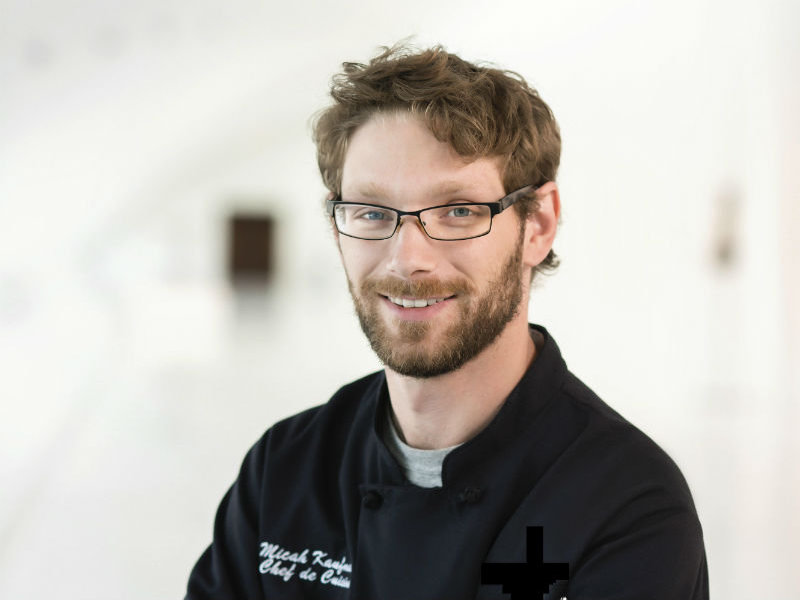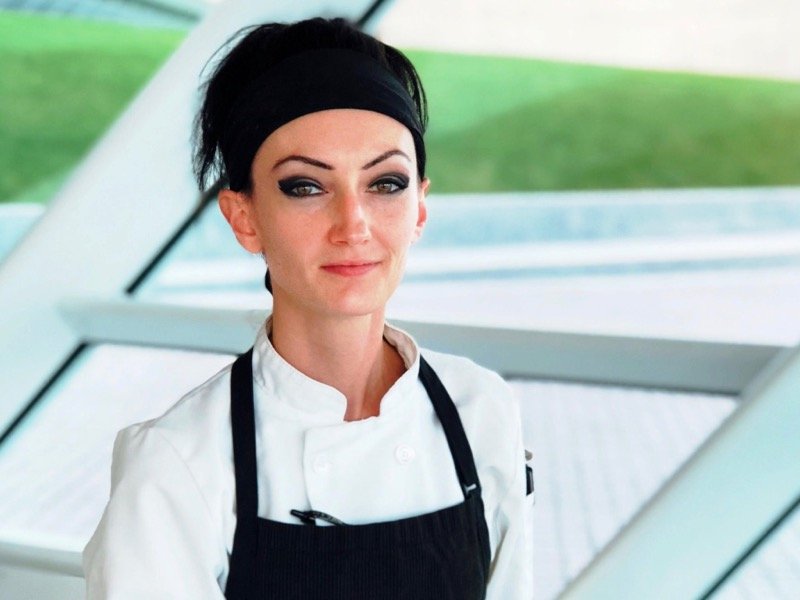For the eighth straight year, October is Dining Month on OnMilwaukee.com, presented by Locavore, the newest restaurant at Potawatomi Hotel & Casino. All month, we're stuffed with restaurant reviews, delectable features, chef profiles and unique articles on everything food, as well as the winners of our "Best of Dining 2014."
You’ve met Milwaukee Art Museum chef Micah Kaufman in the pages of OnMilwaukee.com before, talking about how he creates menus for specific exhibitions at the museum for Cafe Calatrava.
In honor of Kaufman’s promotion to executive chef, we asked him about his background, his work at Milwaukee Art Museum and how his role is evolving there.
OnMilwaukee.com: Give us the Micah story in a nutshell. How you got into cooking and where you’ve worked, etc.
Micah Kaufman: I began cooking when I was 16 at a joint called The Velvet Room in Downtown Milwaukee. The kitchen was a different world for me. I found a meritocracy that didn’t seem to exist in school. No one cared where you were from or what you looked like. Suddenly it was OK to stay out late and hang out with urban miscreants; after all, I was one.
So I dropped out of high school and moved to Florida to work for The Ritz-Carlton, which effectively became my culinary school. After a year, I made enough money to pay for my first semester at UWM. I came back to Milwaukee and bounced between The Bartolotta Restaurant Group and Marcus Hotels, working laterally and growing my culinary skills in the evening, while earning my BA during the day. I graduated in 2011 and began at the Milwaukee Art Museum in 2013.
OMC: Congratulations on your promotion. What does the new title mean for you at Milwaukee Art Museum? How will your job change?
MK: Thanks, Bobby. Executive chef is a big job, even bigger than chef de cuisine. Besides daily operations of Café Calatrava, the coffee shop and catering for private dining, I will be responsible for developing museum culinary programming. Our mission is to enhance the museum experience and develop our culinary programming into an educational resource as well as an amenity. This means working on children’s programming, a lecture series and an "Art of Craft" series, where we invite Wisconsin artisans to demonstrate how their craft has become art, specifically charcuterie, cheese, beer and spirits.
OMC: Are there different pressures and different pleasures running a restaurant in an art museum than running a stand-alone place?
MK: Every restaurant has a unique set of pressures. At the Milwaukee Art Museum we strive to be consistently creative and engage a wide audience. Our guests range from school children to experienced tourists, vegans to weekend warriors and we have something for everyone. One of the greatest pleasures, besides the architecture, is our ability to attract top talent with a quality of life that few restaurants can offer. Without a regular dinner service, servers and cooks are home in time to see their families and catering schedules work well around school. We have an outstanding team that works very hard to take care of our guests, it’s a pleasure to work with them every day.
OMC: Can you explain a bit about how you create a menu that ties to a show like "Of Heaven and Earth"?
MK: "Of Heaven and Earth" is a magnificent exhibition of 500 years of Italian art. There is a wide variety of subject and style, from sacred to landscape, baroque to renaissance. The abundance of culture and history in Italy allows our chefs to take a study in a specific piece, drawing inspiration from the period, artist and most importantly, region. "Of Heaven & Earth" runs through early January which requires the menu to span two seasons. In order to enhance the exhibition in a responsible way we are developing tasting menus of three dishes, changing every two weeks. This allows us to incorporate seasonal ingredients, and work our way across Italy, from Umbria to Sardinia while staying true to the piece and true to the craft.
OMC: What do you like most, and least, about your job?
MK: What I like most about being the executive chef of the Milwaukee Art Museum is the challenge. It is a unique culinary position that demands the traditional skills of a chef, along with an educational and leadership aspect found in very few positions. I have the opportunity to create, teach and execute in the most beautiful building in the Midwest.
What I like least about my job is the challenge. It never ends. Once a menu is written, it is time to write another, learn about another artist, or try another style. This means we have to take risks, not everything works out the way you want it to, but we have a very strong, supportive staff. Their work gets us to the finish line.
OMC: What are favorite restaurants in Milwaukee?
MK: My favorite restaurant is the local one, on the corner, not too far from the house. I feel that it is important to support our neighbors by becoming regulars, giving them feedback and allowing them to cater to you, the community. Get to know the staff, personalize the experience. Some of the best dining experiences I have had were not at the "best" restaurants, but the ones that made me feel welcome and cared for. Right now, my favorite place would be Red Dot.
OMC: Do you have a favorite cookbook?
MK: "White Heat," by Marco Pierre White is a visceral, gritty yet elegant look at a crazy man in the peak of his brilliance. You can tell that he has given everything he has, maybe more, for his craft. The juxtaposition of black and white action shots, and colorful composed dishes demonstrate the intensity required to make something so tranquil and beautiful.
OMC: Do you have a favorite TV or celebrity chef?
MK: I trust PBS. I know that Ming Tsai, Hubert Keller, Lidia Bastiantich, Jacques Pepin, Rick Bayless, Julia Child, Hugh Jackman and our friends at "Wisconsin Foodie" genuinely care about the craft and want to educate their viewers, not make a quick buck off of them. Also, I am very proud to be working for a non-profit in the Milwaukee Art Museum. There is something satisfying knowing that all the hard work ultimately goes to benefit the community instead of an owner or shareholders.
OMC: What's been the biggest development in the culinary arts over the past 10 years?
MK: The most profound development, I feel, is the transition from a competitive model to a collaborative model. It was not that long ago when some chefs treated their knowledge as proprietary or exclusive, afraid to share a recipe or technique for fear that someone else will use it and take "their" business.
There has been an explosion of creative and unique restaurants run by chefs who became frustrated in the limits of competition. These days our kitchens are open, not closed. We invite each other into our restaurants to collaborate, we promote our local producers because we are all part of the same food system. A rising tide raises all boats, so to speak.
OMC: What kitchen utensil can't you live without?
MK: I can’t live without my table spoon. I can do a lot with a knife, but I can’t do anything without a spoon. I use it to taste, to plate, to point, to sauce and to drum a little beat in between orders. It is a remarkably versatile tool in the right hands. I have a favorite that I don’t use at work because it means too much to me.
OMC: What's the next big trend in food?
MK: What is old is new again, which seems to happen over and over. I am seeing a lot of veggie centric dishes out there, good price points, creative technique and approachability because they appeal to a wide variety of dietary restrictions. It is also easier to experiment with vegetables because they are less expensive and more humane than meat, so development is a lower risk step, allowing for more creativity and availability.
OMC: What's the toughest day / night to work in the restaurant biz?
MK: The toughest day or night is reserved for certain roles, certain shifts. Every kitchen is different, but the toughest day is for the prep cook on Monday morning. Stations are empty, the space is usually disorganized from a busy weekend, and fresh product hasn’t come in yet. The Monday morning prep cook also has all the big projects to start over, making pasta, roasting bones, cutting copious amounts of mire poix.
The hardest night is the Saturday night dishwasher. Besides the chaos of a busy service, being on the bottom of the totem pole, fire and knives all around you, it is a largely thankless and humbling job. Many cooks have contemplated their purpose standing in a dish pit at 11 p.m. on a Saturday night while all their friends are out having fun, wondering why they ever wanted to do this. The future chefs stay, the wannabes walk.
OMC: What is your favorite guilty dining pleasure?
MK: I really like starting a big meal with an aperitivo, usually Frenet Branca. It whets the appetite, cleanses the palate and liquors me up for what is to come. Also, finishing the meal with an espresso rejuvenates my energy, aids digestion and adds a sobering transition, back to the real world.
OMC: Do you have a favorite artist?
MK: Favorite artist is a big question. Personally, I am inspired by the Dada and Cubist movements of the early 20th century. Culturally there was a shift from agrarian to industrial societies culminating in a Great War that almost destroyed the world. This begged the question, "Is it really advancement, if it results in destruction?"
Artists like Manierre Dawson and Marcel Duchamp created works that questioned our understanding of what art is, what is its purpose and who it is for. They sought to move beyond retinal or aesthetic art, challenging viewers instead of entertaining them. I believe the difference between art and craft is the message.
Art challenges our beliefs, what we know and what we think we know. A craft is a collection of techniques, practices and dedication. Santiago Calatrava mastered the techniques of his craft, architecture, elevating them to the level of art which has become this icon for our great city. Mastering my craft, elevating it to art, is something that I will continue to pursue for the rest of my life.ac
Born in Brooklyn, N.Y., where he lived until he was 17, Bobby received his BA-Mass Communications from UWM in 1989 and has lived in Walker's Point, Bay View, Enderis Park, South Milwaukee and on the East Side.
He has published three non-fiction books in Italy – including one about an event in Milwaukee history, which was published in the U.S. in autumn 2010. Four more books, all about Milwaukee, have been published by The History Press.
With his most recent band, The Yell Leaders, Bobby released four LPs and had a songs featured in episodes of TV's "Party of Five" and "Dawson's Creek," and films in Japan, South America and the U.S. The Yell Leaders were named the best unsigned band in their region by VH-1 as part of its Rock Across America 1998 Tour. Most recently, the band contributed tracks to a UK vinyl/CD tribute to the Redskins and collaborated on a track with Italian novelist Enrico Remmert.
He's produced three installments of the "OMCD" series of local music compilations for OnMilwaukee.com and in 2007 produced a CD of Italian music and poetry.
In 2005, he was awarded the City of Asti's (Italy) Journalism Prize for his work focusing on that area. He has also won awards from the Milwaukee Press Club.
He has be heard on 88Nine Radio Milwaukee talking about his "Urban Spelunking" series of stories, in that station's most popular podcast.







